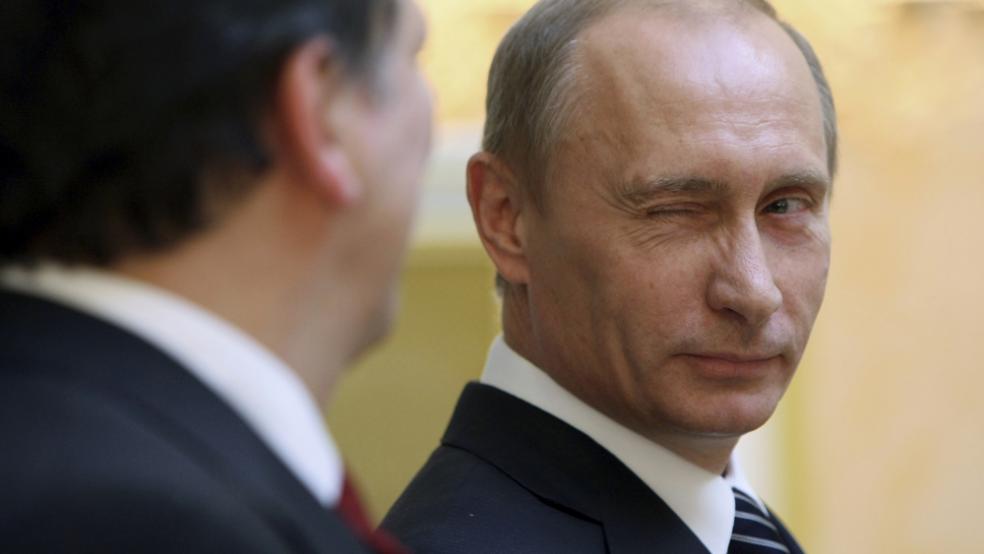Russian President Vladimir Putin’s decision to intervene in the ongoing civil war in Syria has been accompanied by a major public relations push in the Russian media. From weather reports assessing the conditions for bombing in Syria to social media posts from the military highlighting the Russian military’s attacks on the enemies of Syrian dictator Bashar al-Assad, the multiple state-run media outlets that dominate the Russian news media have been feeding the country a steady diet of stories about Russian military might.
On Wednesday, the Russian people got a look at what is believed to be the first use of Russia’s new Kalibr-NK cruise missile, and Putin used the occasion to tweak the U.S. and its allies, which have been bombing targets in Syria for months, offering to destroy ISIS facilities for them. The implication, plainly, is that other forces in the region might not have the same capabilities as his.
Related: Is Putin’s Next Step to Intervene in Iraq?
“If they say they are abreast of the situation better than we are, because they have operated in Syria for over six months (illegally, by the way, as I have told them recently), let them provide us with targets they have found, and we will destroy them,” Putin offered.
More than two dozen of the Russian missiles were fired into Syria from ships 900-plus miles away in the Caspian Sea, and were apparently part of the support for a large ground offensive being launched by the Syrian Army against rebel groups fighting the Assad regime.
The use of the cruise missiles puzzled some experts, such as HIS Janes analyst Jeremy Binnie, who told The Washington Post that the Russian military has other assets in the region that could have managed to take out the targets struck on Wednesday. Cruise missiles, fast and hard to detect on radar, are typically used at the outset of a campaign to disable enemy positions with little or no warning.
But Russia has been bombing Syria for more than a week at this point, making it unclear why Putin would choose to mount a cruise missile attack at this point in the campaign.
Related: Obama Rewrites His Syria Plan, but Is It a Strategy?
A possible clue is the speed with which the strikes were publicized by the Kremlin. Putin was formally told of the strikes’ success in televised remarks made by Defense Minister Sergei Shoigu. Soon state-run media outlets were running photographs and video clips of what they told their audience were the actual missile launches.
The reports all noted the range of the missiles, which are a new addition to the Russian arsenal, and their technical sophistication. They all also pointed out that all 26 of the missiles struck within three meters of their intended targets, and claimed that no civilian buildings were damaged.
In televised remarks Putin said, “The fact that we have launched precision-guided weapons from the Caspian at a range of around 1,500 km and hit all the targets indicates the good status of defense industry and the good skills of the personnel.”
The fact that the strikes were launched from the Caspian Sea is also significant, because it required the missile to travel over parts of both Iran and Iraq before entering Syrian airspace. This tacitly highlighted the recently announced partnership between the Kremlin, Iran, Iraq, and Syria to fight the extremist group ISIS.
Related: Why Donald Trump Is Vladimir Putin’s Favorite Presidential Candidate
Russian General Staff Colonel General Andrey Kartapolov told TASS that the military had “reached an agreement in advance with our partners on making the cruise missile strikes."
However, it also raised the question of whether U.S. officials were made aware of the pending missile attack in advance, as the weapons also had to pass through part of the region where U.S. and allied warplanes are conducting operations against ISIS.
In his televised remarks, Shoigu suggested that the missile strikes had targeted ISIS, and added that to date Russian planes have carried out 112 strikes against ISIS targets.
Related: 14 Deadly Weapons Russia Has Sent to Syria
“Since September 30, 19 control centers, 12 ammunition dumps, 71 armored vehicles, and factories and workshops making high-explosives and improvised explosive devices (IEDs) to fit cars, etc., six workshops and plants like that have been destroyed. We continue to operate as planned,” he said.
However, multiple international groups, as well as Syrian rebels supported by the U.S., have claimed that ISIS has virtually no presence in the areas Russia has attacked – including those struck by missiles Wednesday. Instead, they claim, the Kremlin appears to be targeting rebel groups opposed to Assad.





